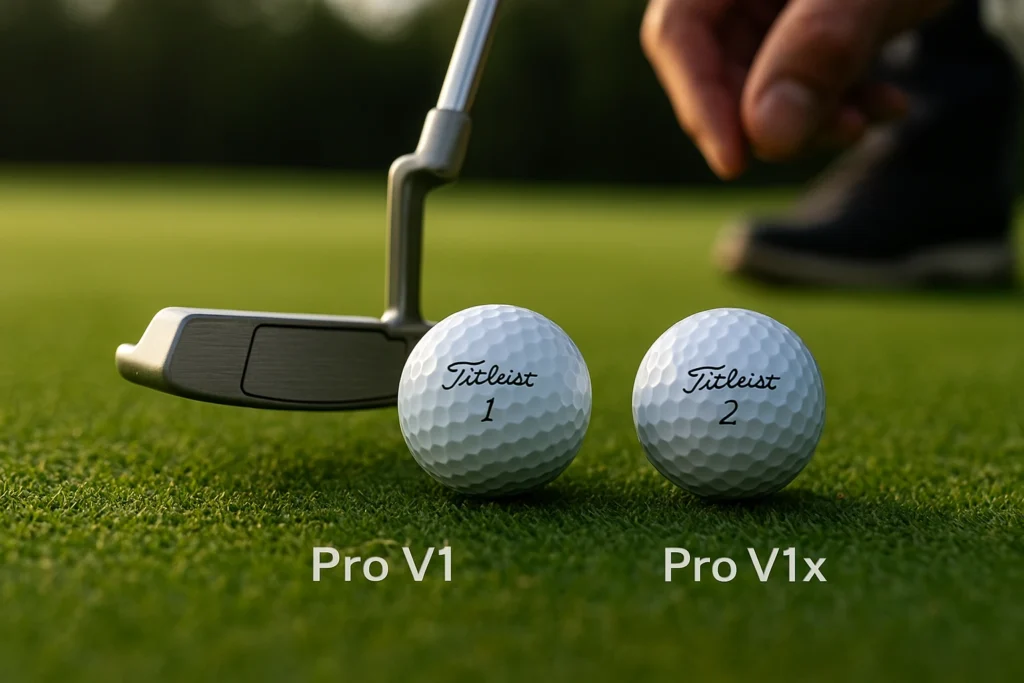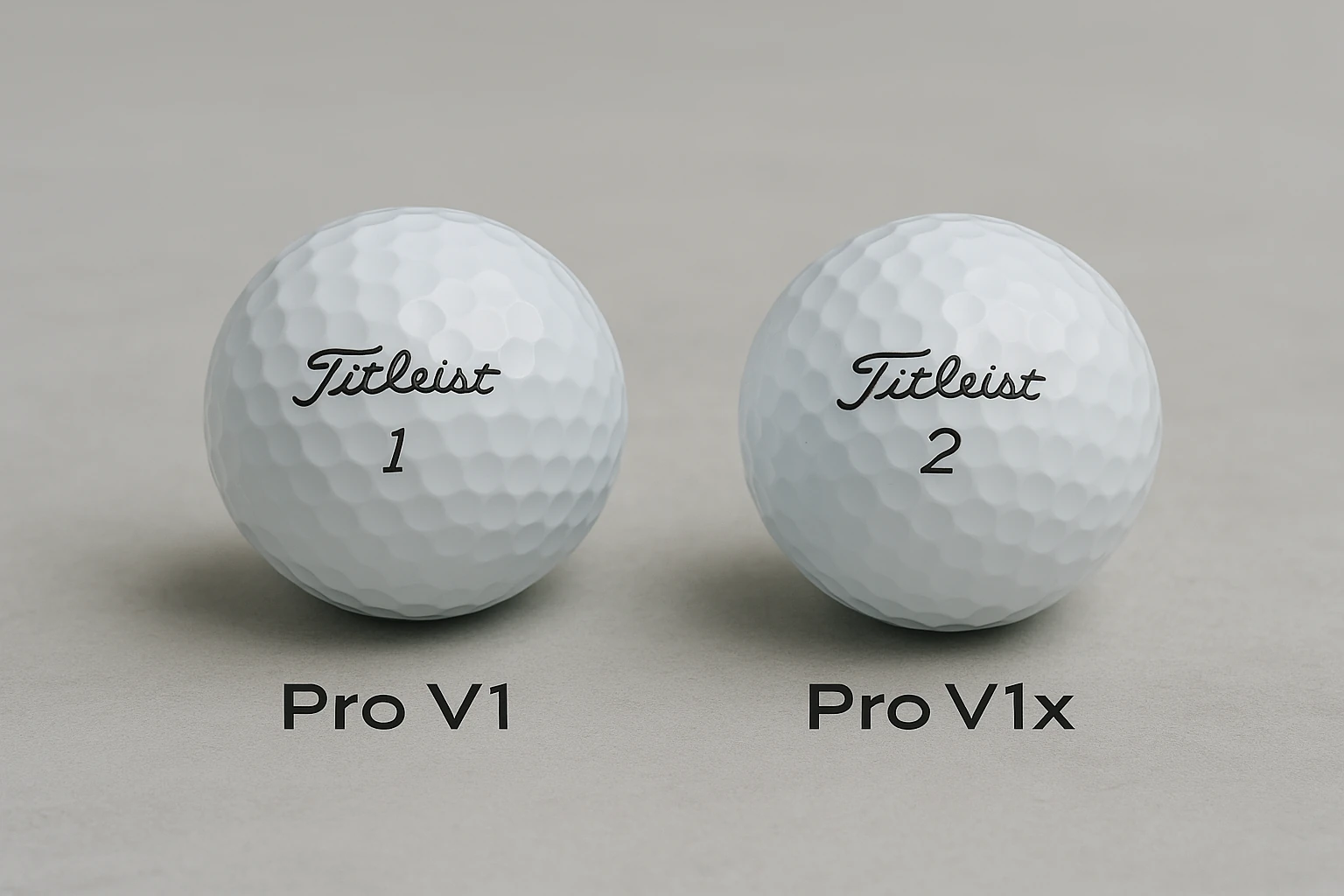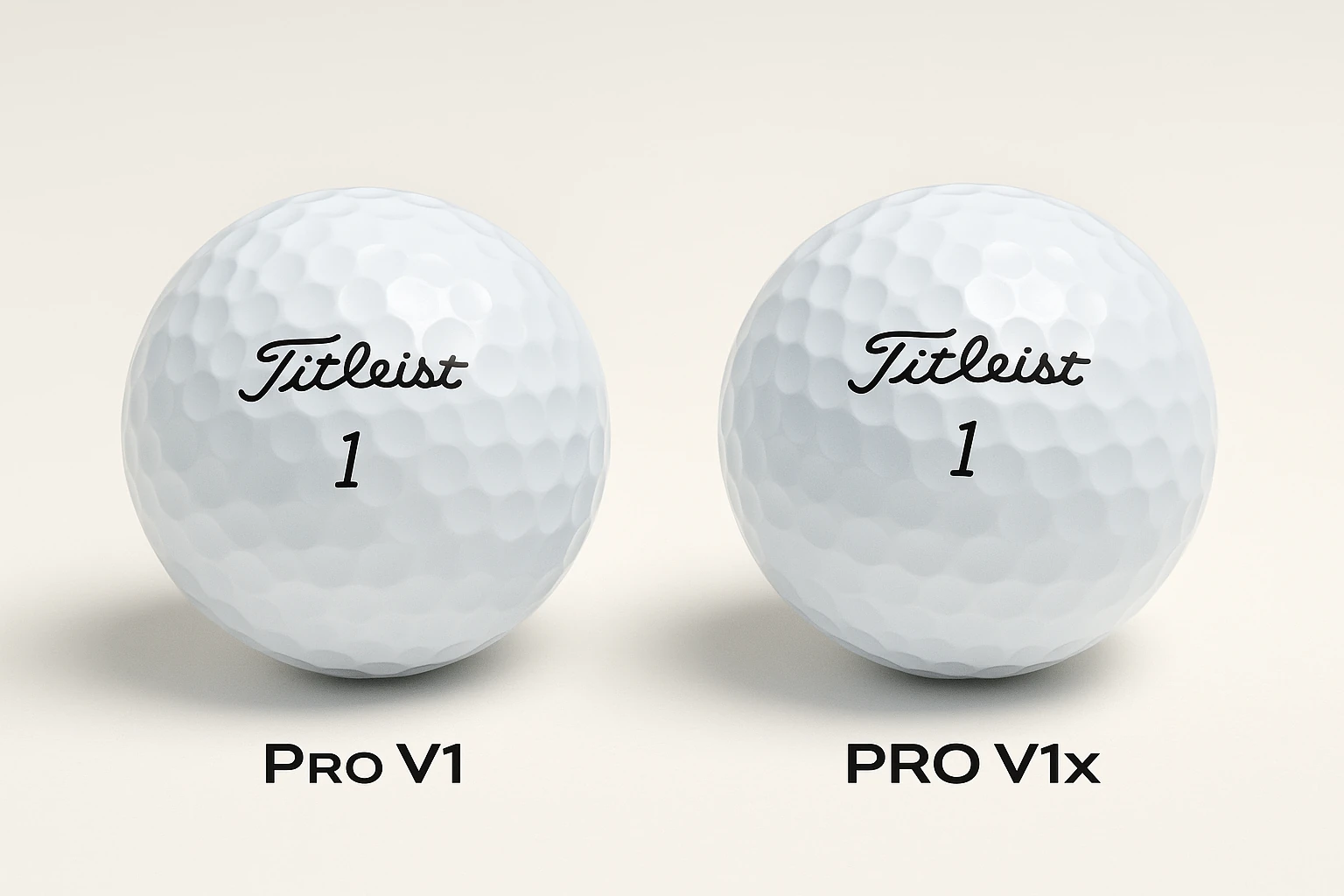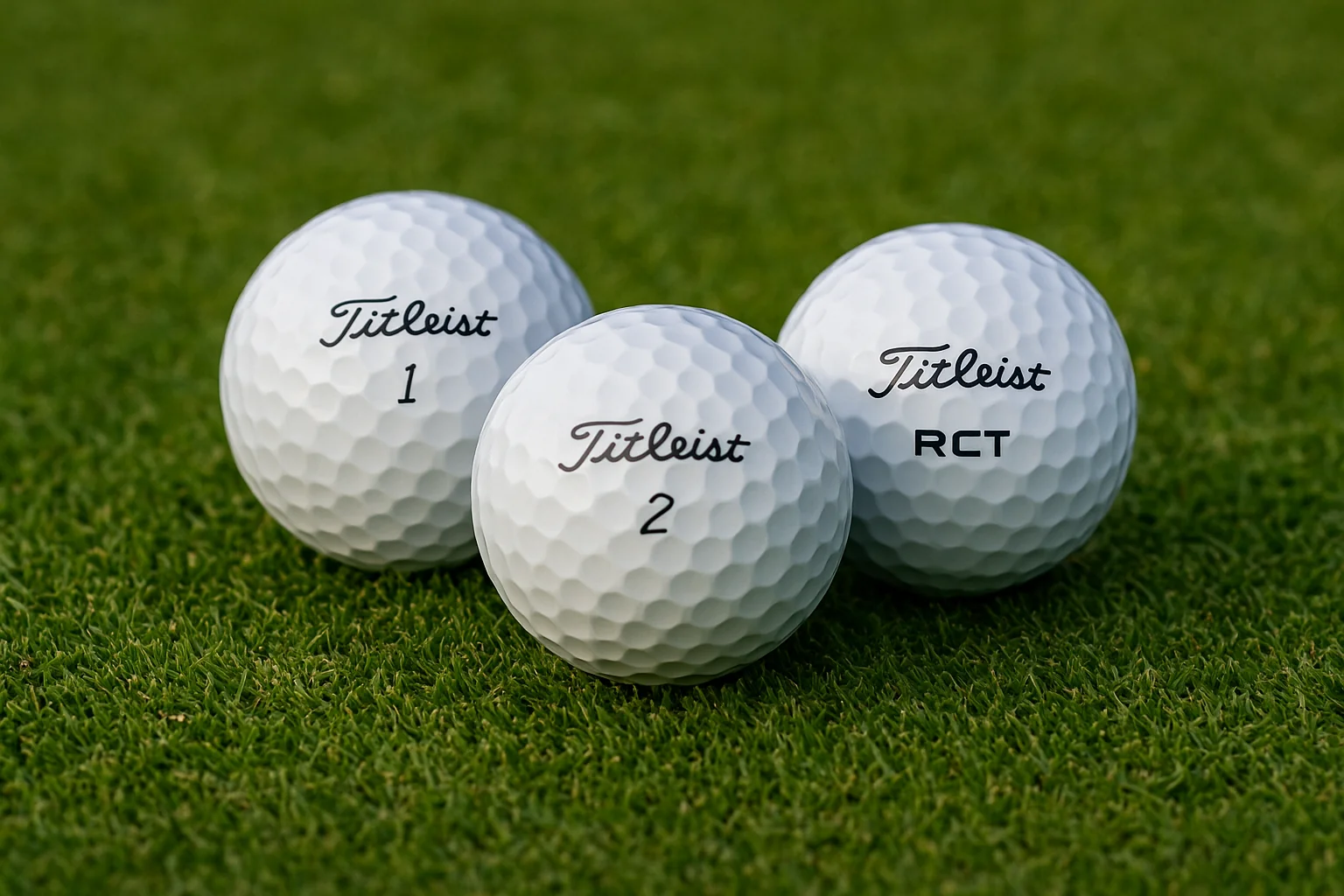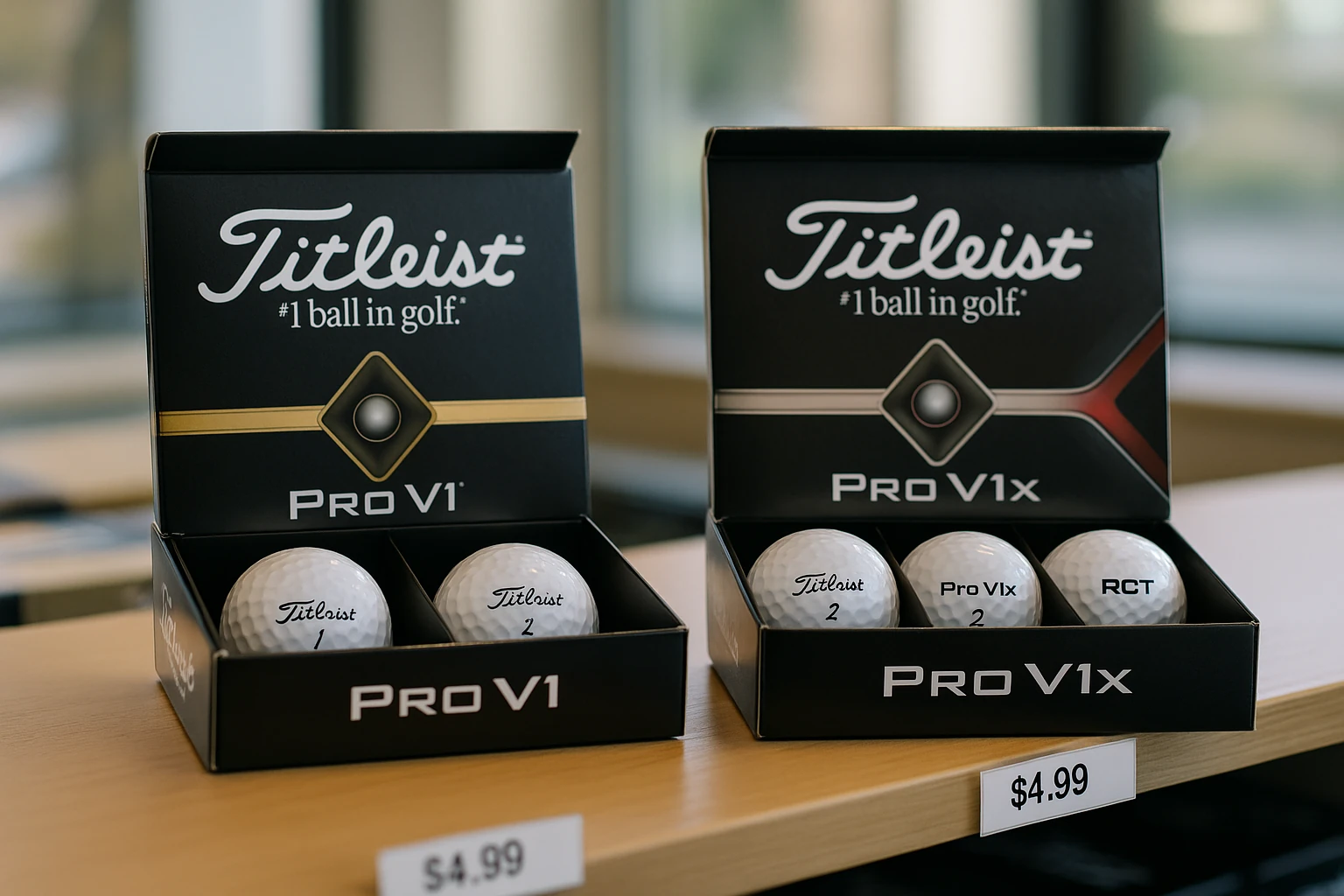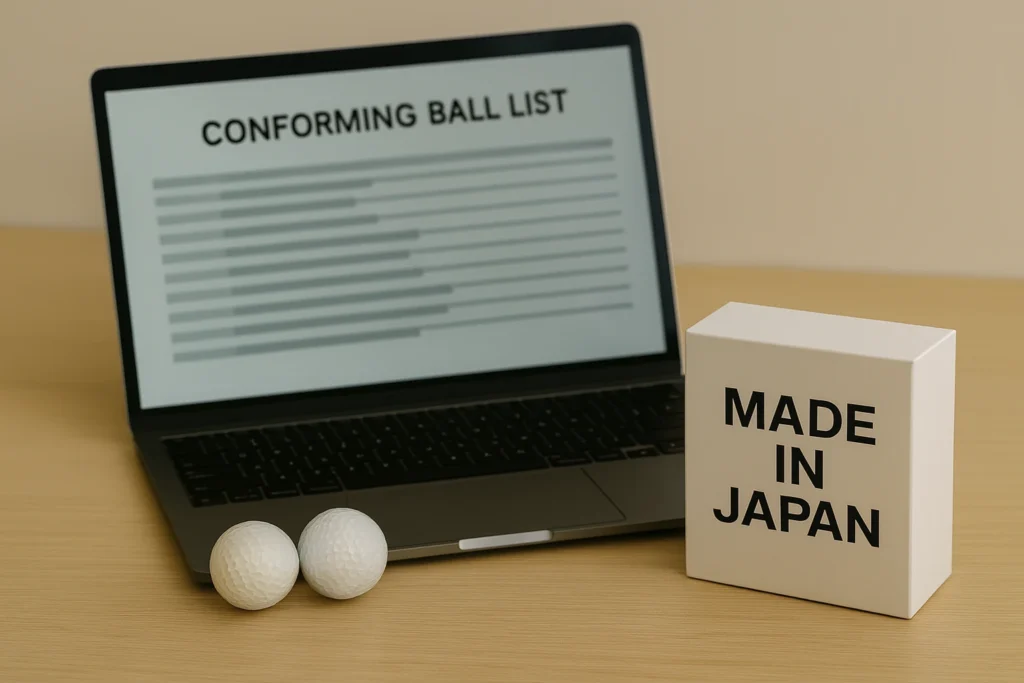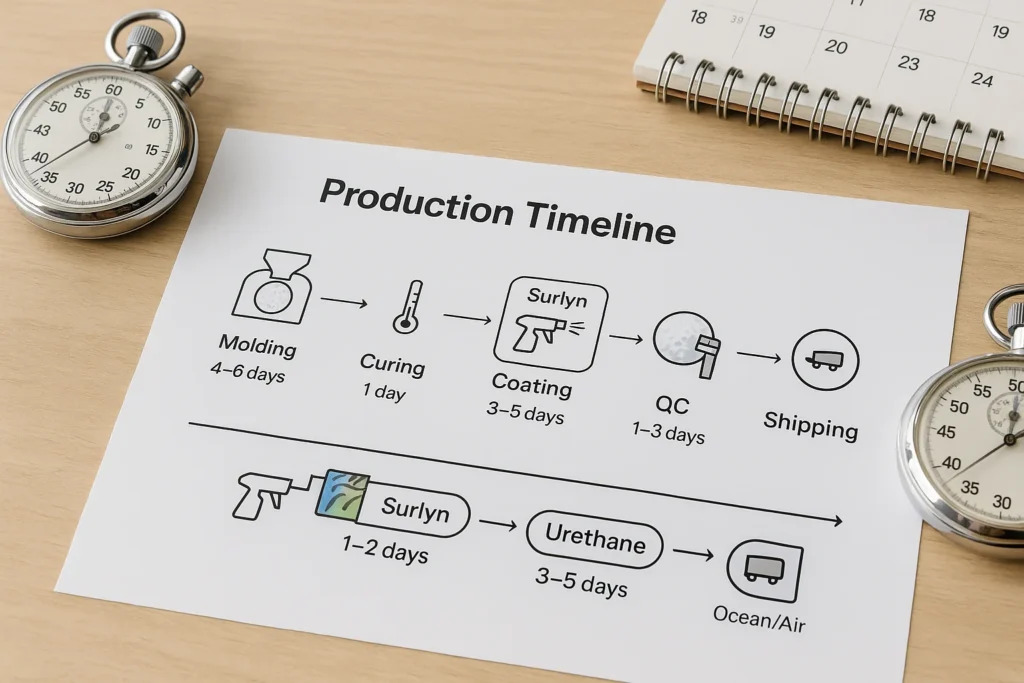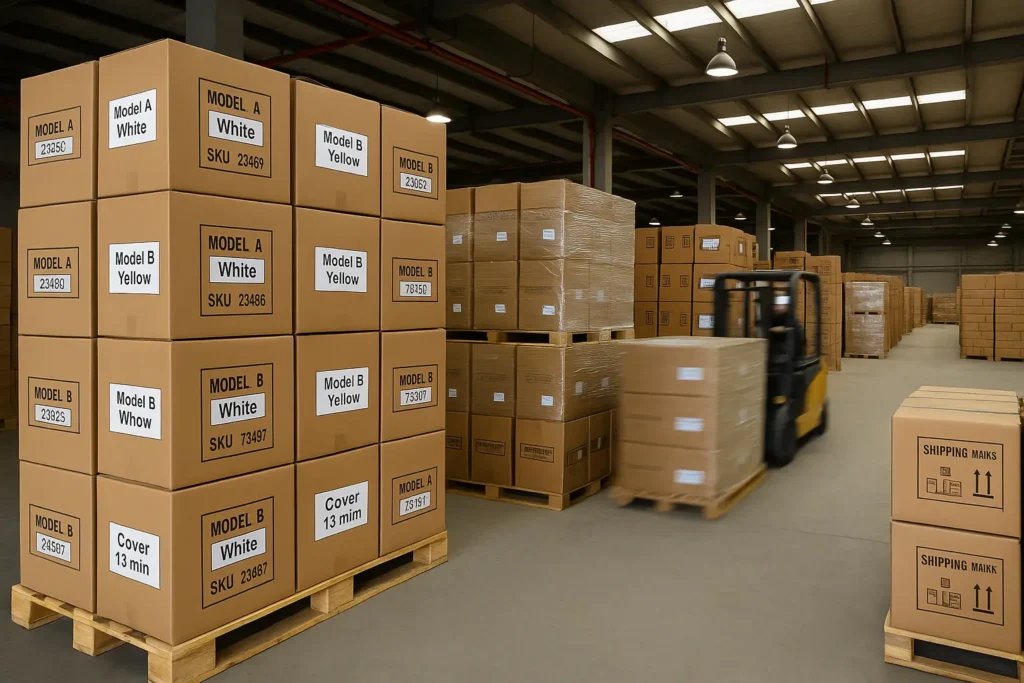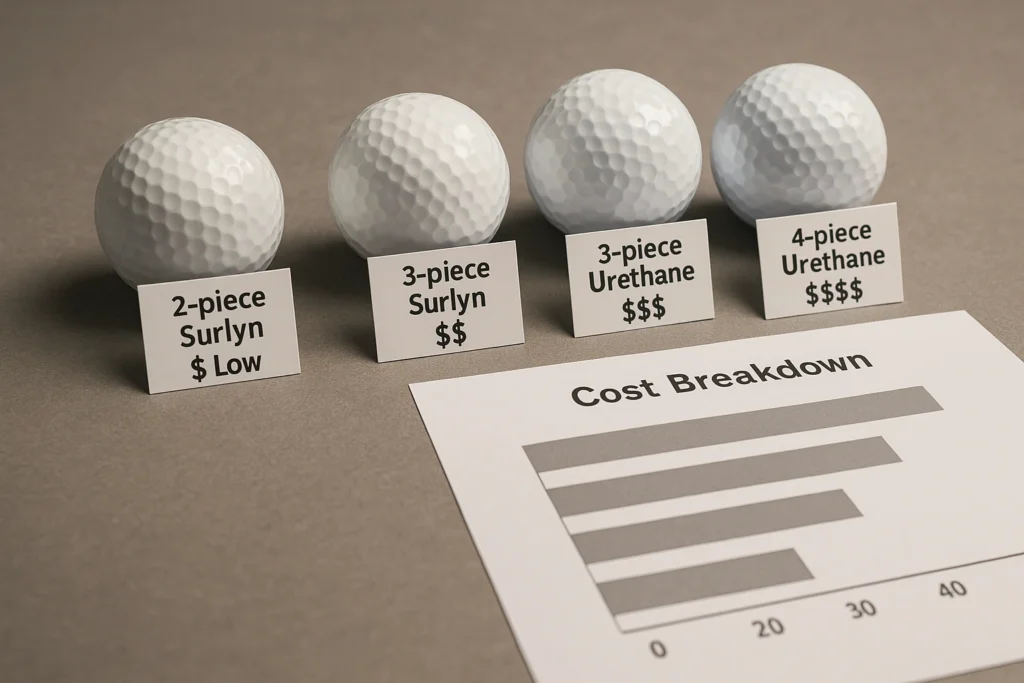Pro V1 suits golfers who prefer lower flight and softer feel, while Pro V1x suits players seeking higher launch and more spin control.
The main difference between Pro V1 and Pro V1x lies in flight, spin, and feel: Pro V1 is softer with lower trajectory and more roll-out, while Pro V1x launches higher, spins more with irons, and stops faster on greens.
| Feature | Pro V1 | Pro V1x |
|---|---|---|
| Construction | 3-piece, soft compression | 4-piece, dual-core, firmer feel |
| Flight | Mid launch, penetrating flight | High launch, steeper descent |
| Spin | Low driver spin, moderate iron spin | Low driver spin, high iron/wedge spin |
| Feel | Soft, muted sound | Firm, crisp sound |
| Retail Price (US) | ~$55/dozen | ~$55–$58/dozen |
How are Pro V1 and Pro V1x built?
Pro V1 is a 3-piece ball using a soft single core, while Pro V1x adds a dual-core 4th layer to increase speed and enhance spin separation.
Construction determines how a golf ball feels and reacts off each club.
The Pro V1’s three-piece design includes a reformulated core, casing layer, and a soft cast urethane elastomer cover. This results in a balanced feel and moderate responsiveness.
Pro V1x, in contrast, includes a larger dual-core and an additional casing layer. The casing enhances ball speed and fine-tunes spin between long and short shots. Although the cover is the same material as the V1, the internal difference creates a noticeably firmer experience.
| Component | Pro V1 | Pro V1x |
|---|---|---|
| Layers | 3-piece | 4-piece (dual-core) |
| Core | Single soft compression core | Dual-core for increased speed |
| Casing Layer | Single mantle layer | Dual mantle layers |
| Cover | Cast urethane elastomer | Same |
| Overall Feel | Softer | Firmer |
| Manufacturing | Precision molded | Same |
How do they differ in flight and trajectory?
Pro V1 flies lower with a more stable trajectory, while Pro V1x launches higher and lands at a steeper angle, ideal for stopping power.
Trajectory is critical for distance and control.
Pro V1’s penetrating flight makes it a strong fit for windy conditions and players who prefer lower ball flight. It helps optimize roll-out, especially on firm fairways.
Pro V1x, however, excels in producing high launch and a steep descent angle. This is beneficial when players need to hit into firm greens or stop the ball quickly from long distances.
Dimple count also affects aerodynamics. Pro V1 has 388 dimples, while Pro V1x has 348. The pattern creates different air resistance, reinforcing each model’s natural trajectory.
| Flight Metric | Pro V1 | Pro V1x |
|---|---|---|
| Launch Height | Mid | High |
| Descent Angle | Moderate | Steep |
| Wind Performance | More stable | More affected |
| Roll-Out Potential | Higher | Lower due to quicker stopping |
| Dimple Count | 388 | 348 |
✔ True — Distance performance is tied to launch and roll behavior
Pro V1 may produce more roll-out due to its lower launch, while Pro V1x could carry farther thanks to its higher trajectory. The best fit depends on your swing dynamics.
✘ False — “One model always flies farther”
There’s no fixed winner in distance. It’s not about model specs—it’s how each ball reacts to your launch angle and spin conditions.
Feel & Sound
Pro V1 provides a softer, more muted touch, while Pro V1x feels firmer and produces a sharper, crisper sound across all clubs.
Feel is subjective, but it influences confidence—especially in putting and finesse shots.
Pro V1 is known for its soft compression feel. The response is buttery and quiet off putters, wedges, and irons.
Pro V1x appeals to players who want tactile feedback. The ball feels firmer off the clubface and produces a clickier sound, especially with putters. This is often preferred by those who want audible confirmation of solid contact.
| Feel Factor | Pro V1 | Pro V1x |
|---|---|---|
| Putter Feel | Soft, muted | Firm, crisp |
| Short Game Contact | Buttery | Responsive, snappy |
| Sound Feedback | Low-pitch | High-pitch |
| Full Swing Feel | Slight compression | Solid strike |
Which one should I play?
If you prefer soft feel, mid flight, and roll-out, choose Pro V1. If you want high flight, added iron spin, and more stopping power, go with Pro V1x.
| Player Type | Pro V1 | Pro V1x |
|---|---|---|
| Swing Speed | Moderate to fast | Fast to very fast |
| Shot Shape Control | Prioritizes consistency | Prioritizes stopping power |
| Wind Performance | Better | Can balloon |
| Feel Preference | Soft, smooth | Crisp, firm |
| Spin Needs | Balanced | Higher on short shots |
✔ True — Both balls are widely used on Tour based on fit
Many top pros use either Pro V1 or Pro V1x. For example, Jordan Spieth favors Pro V1x for its stopping power, while Justin Thomas chooses Pro V1 for wind control. Fit trumps brand prestige.
✘ False — “Only elite players use Pro V1x”
It’s a myth that Pro V1x is always a pro-level ball. It suits players who need high launch and spin—not necessarily elite skills.
Are there special variants like Left Dot / Left Dash / RCT?
Yes—Left Dot offers lower flight and less spin than standard V1; Left Dash delivers high flight and lowest spin among Titleist balls; RCT models are made for radar-based indoor tracking.
Titleist created these variants for elite players and fitting specialists:
- Left Dot is a Pro V1 derivative with slightly lower spin and lower trajectory. It’s harder to find but loved by Tour players seeking mid-launch and limited spin.
- Left Dash is firmer than even Pro V1x, with low spin and high flight—ideal for high-speed players battling ballooning shots.
- RCT (Radar Capture Technology) versions of both V1 and V1x are optimized for use with launch monitors like TrackMan in indoor settings.
| Model | Based On | Launch | Spin | Feel | Best Use Case |
|---|---|---|---|---|---|
| Left Dot | Pro V1 | Lower | Low | Soft | Lower spin, Tour fit |
| Left Dash | Pro V1x | High | Lowest | Firmest | High speed, balloon control |
| Pro V1 RCT | Pro V1 | Same | Same | Same | Indoor radar tracking |
| Pro V1x RCT | Pro V1x | Same | Same | Same | Indoor radar tracking |
Do dimples and compliance matter?
Yes—dimple count and aerodynamics influence ball flight, and both models are USGA and R&A approved for legal play.
The Pro V1’s 388 dimples help create a consistent, lower flight.
The Pro V1x’s 348 dimples promote a higher trajectory.
Both meet all conformity standards set by the USGA and R&A, meaning they’re tournament legal at any level of play. Titleist maintains strict tolerances in their manufacturing to ensure every ball performs within specs.
| Feature | Pro V1 | Pro V1x |
|---|---|---|
| Dimple Count | 388 | 348 |
| Dimple Pattern | Spherically-tiled tetrahedral | Spherically-tiled tetrahedral |
| Flight Focus | Lower, stable | Higher, steep |
| USGA/R&A Approved | Yes | Yes |
Which ball fits your game and budget?
Both Pro V1 and Pro V1x retail for about $55 per dozen in the U.S. Pro V1 suits golfers who prefer softer feel, mid flight and consistency, while Pro V1x fits players seeking higher launch, firmer feel and sharper stopping. Pro V1x may cost slightly more in some markets, but performance fit should guide choice.
| Consideration | Pro V1 Preference | Pro V1x Preference |
|---|---|---|
| Feel | Softer | Firmer |
| Flight | Mid/penetrating | High/steep |
| Stopping Power | More roll | Faster stop |
| Price (US) | ~$55/dozen | ~$55–$58/dozen |
✔ True — Price isn’t the best performance signal
Though Pro V1x may cost slightly more in some places, both models are premium and designed for specific flight/spin profiles. Choosing by fit—not price—leads to better results.
✘ False — “Pro V1x is more expensive, so it must be better”
Price varies by market and demand. The right ball depends on how it matches your game—not its MSRP tag.
Quick selection checklist
Soft feel and mid flight → Pro V1. High launch and iron spin → Pro V1x. Need low spin → Left Dot or Left Dash. Using indoor radar → RCT model.
| If You Want… | Choose… |
|---|---|
| Softer feel | Pro V1 |
| Higher launch and wedge spin | Pro V1x |
| Lower spin overall | Left Dot/Dash |
| Use with TrackMan indoors | RCT version |
| Balanced performance | Pro V1 |
Durability & Cover Performance
Both Pro V1 and Pro V1x use durable cast urethane covers, designed to withstand full-swing wedge shots and last multiple rounds.
While urethane is softer than ionomer, Titleist engineers their covers for pro-level durability without sacrificing spin or feel.
In independent testing, both balls resist scuffing better than average tour balls. Pro V1x may show less visible wear due to its firmer structure.
| Durability Metric | Pro V1 | Pro V1x |
|---|---|---|
| Cover Material | Cast urethane elastomer | Same |
| Scuff Resistance | High | High |
| Rounds per Ball | 3–5 | 3–6 |
| Tour Validation | Yes | Yes |
| MOI Consistency | High | High |
FAQ
Is Pro V1 longer than Pro V1x?
Distance depends on your swing speed and fit. Pro V1x may fly higher and stop faster, but Pro V1 rolls out more. Neither is always longer.
Do compression numbers decide performance?
No. Titleist doesn’t publish exact compression ratings. Focus instead on feel, spin, and trajectory.
Do PGA Tour players use both models?
Yes. Top players choose based on launch, feel, and control preferences. There’s no single right answer.
Which ball is better for windy conditions?
Pro V1’s mid, penetrating flight makes it more stable in strong winds, while Pro V1x can balloon more due to higher launch.
Do Pro V1 and Pro V1x feel different on putts?
Yes. Pro V1 feels softer and more muted off the putter, while Pro V1x feels firmer with a crisper sound.
Is there a big price difference between Pro V1 and Pro V1x?
In the U.S., both retail for about $55/dozen, though Pro V1x can be a few dollars higher in some markets.
Are Pro V1 and Pro V1x suitable for beginners?
Both are premium balls designed for advanced control. Beginners can use them, but lower-cost Titleist balls (e.g., Tour Soft, TruFeel) may be more budget-friendly.
✔ True — Titleist Tour validation shows both models are trusted at the highest level
Pro V1 and Pro V1x are played across PGA, LPGA, and Korn Ferry Tours. Choice is based on fit—spin, height, and feel—not model tier or status.
✘ False — “Tour pros only use Pro V1x because it’s better”
Pro V1 is also widely trusted. Tour use depends on what flight and spin profile best matches each player—not which model is newer or firmer.
Key Takeaway
Pro V1 vs Pro V1x is all about flight, spin, and feel differences. Pro V1 offers lower flight and soft feel—ideal for windy conditions and smoother spin players. Pro V1x launches higher, spins more into greens, and gives firmer feedback—perfect for aggressive swingers needing carry and control. Both cost about $55/dozen. Pro V1 is better for players seeking consistency and feel, while Pro V1x favors golfers wanting control, height, and spin precision.
Since 2012, Golfara has supported companies like yours with high-quality, customizable golf balls shipped globally. Want expert insight on sourcing top-performing balls like Pro V1? We’re ready to help.
You might also like
Can Chinese golf ball factories actually manufacture Pro V1 and Pro V1x caliber balls?
Can Chinese Factories Make Pro V1 & Pro V1x-Level Golf Balls?

